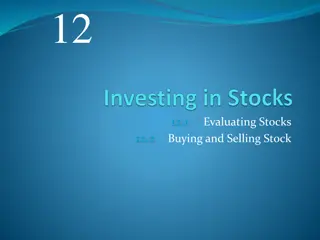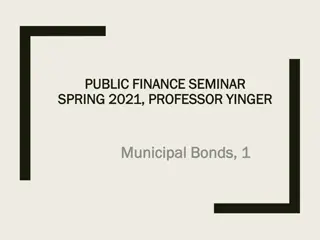Understanding Bonds and Stocks for Investments
Your company can raise funds for new investments by selling additional shares of stock or issuing bonds. Stocks represent ownership in a corporation, while bonds are long-term loans. Valuing bonds involves calculating present value based on coupon payments and face value. Examples with French and German bonds illustrate the valuation process.
Download Presentation

Please find below an Image/Link to download the presentation.
The content on the website is provided AS IS for your information and personal use only. It may not be sold, licensed, or shared on other websites without obtaining consent from the author. Download presentation by click this link. If you encounter any issues during the download, it is possible that the publisher has removed the file from their server.
E N D
Presentation Transcript
BONDS AND STOCKS Suppose your Company wants to invest in new plant and equipment. These investments require money often a lot of money! WHAT CAN YOUR COMPANY DO? You can sell additional shares of stock You can issue bonds, which are simply long-term loans
DIFFERENCE BETWEEN BONDS AND STOCKS It means in italian Titolo Stock: a security representing ownership of a corporation If you buy a stock you are one owner of the corporation
DIFFERENCE BETWEEN BONDS AND STOCKS Bond: Long-term debt Companies are not the only bond issuers. Municipalities also raise money by selling bonds. So do national goverments. If you buy a bond you are a creditor Issues Bonds Which are part of their debt
VALUING BONDS Terminology Bond - Security that obligates the issuer to make specified payments to the bondholder. Face value (par value or principal value) - Payment at the maturity of the bond. Coupon - The interest payments made to the bondholder.
VALUING BONDS The price of a bond is the present value of all cash flows generated by the bond (i.e. coupons and face value) discounted at the required rate of return In this case it equals the rate of return offered by other government debt issues + cpn + cpn + ( cpn par ) = + + + PV .... + 1 2 t 1 ( ) 1 ( ) 1 ( ) r r r
VALUING BOND 1 1 1 1 (1 + ?)1 (1 + ?)3 (1 + ?)2 (1 + ?)4 2018 2014 2017 2016 2015 Cpn + face value +4.25% of 100 + 100 (the face value) So 104.25 cpn +4.25% of 100 So 4.25 cpn +4.25% of 100 So 4.25 cpn +4.25% of 100 So 4.25 -100
VALUING BONDS Example - France In October 2014 you purchase 100 euros of French bonds (OATs Obligations Assimilables du Tr sor) which pay a 4.25% coupon every year. If the bond matures after 4 years the YTM is 0.15%, what is the value of the bond? . 4 25 . 4 25 . 4 25 104 25 . 4.25% of 100 is 4.25 100 + 4.25 = + + + PV ( . 1 ) ( . 1 ) ( . 1 ) 2 3 4 0015 . 1 0015 0015 0015 = euros 34 . 116
VALUING BONDS A 10-year German government bond (bund) has a face value of 100 and a coupon rate of 5% paid annually. Assume that the interest rate (in euros) is equal to 6% per year. What is the bond's PV? PV= (1+0.06)+ 5 5 5+100 (1+0.06)10=92.69 (1+0.06)2+ +
VALUING STOCKS Dividend Discount Model - Computation of today s stock price which states that share value equals the present value of all expected future dividends Div is affected by earnings! + Div + Div + Div P = + + + ... 1 2 H + H P 0 1 2 H 1 ( ) 1 ( ) 1 ( ) r r r H - Time horizon for your investment.
VALUING STOCKS Company X is expected to pay an end-of-year dividend of $5 a share. After the dividend its stock is expected to sell at $110. If the market capitalization rate is 8%, what is the current stock price? P0= (Div1+ P1) / (1 + r) P0= ($5 + 110) / 1.08 P0= $106.48
REMEMBER! r=? ? r=? ? 12 4 ex 3 = r=? 12 3 = 4 16 4 = 4 ? r=? 12 6 = 2 8 4 = 2 ? r means result n means numerator d means denominator
VALUING STOCKS AND BOND We can write the previous formulas as: ? ? ? +?? (1+??+? 1 ???= ????+1 ????+2 ????+? ? + ) + ) ? ? 1+?? (1+??)(1+??+1 (1+??) 1+??+1 ? ? ? +?? (1+??+? 1 ???= ????+1 ????+2 ????+? ? + ) + ? ? 1+?? (1+??)(1+??+1 (1+??) 1+??+1 )
Unexpected- Expected- already expected M/F POLICY Unexpected Change in i M/F POLICY Expected Change in ?? M/F POLICY We already knew that already expected No impact
MACROFINANCE What happens to the price of Stock and to the price of Bond if the Central Bank applies an unexpected Expansionary Monetary Policy? i LM ?? i ; Y LM i* Div price Stock i i IS Bond i price Y* Y Y The bond price is affected only by the interest rate because the cpn is fixed
MACROFINANCE What happens to the price of Stock and to the price of Bond if the Central Bank applies an expected (in the future) Expansionary Monetary Policy? i LM ?? ??; Y LM i* ?? Div price Stock i IS ?? Bond price Y* Y Y The bond price is affected only by the interest rate because the cpn is fixed
MACROFINANCE What happens to the price of Stock and to the price of Bond if the Central Bank applies an unexpected Restrictive Monetary Policy? i LM ?? i ; Y LM i Stock Div price i* i IS Bond i price Y Y* Y
MACROFINANCE What happens to the price of Stock price and to the Bond price if the Central Bank applies an expected Restrictive Monetary Policy? i LM ?? ?? ; Y LM i Div price ?? Stock i* IS ?? Bond price Y Y* Y
MACROFINANCE What happens to the price of Stock and to the price of the Bond if the Central Bank applies an unexpected Espansionary Fiscal Policy? Observation i LM T i ; Y i i* i price Bond IS Div ; i Stock IS What will the result be? It depends on how flat the curve LM is! Y* Y Y
MACROFINANCE What happens to the price of Stock if the Central Bank applies an expected Espansionary Fiscal Policy? Observation i LM T ??; Y i i* ?? price Bond IS Div ; ?? Stock IS What will the result be? It depends on how flat the curve LM is! Y* Y Y
MACROFINANCE What happens to the price of Stock if the Central Bank applies an unexpected Espansionary Fiscal Policy? Observation: LM almost flat i T i < Y LM Bond i price i i* Div > i Stock IS IS What will the result be? Y* Y Y In this case we have an increase in the stock price because the increase of Div is higher than the increase of i.
MACROFINANCE What happens to the price of Stock if the Central Bank applies an expected Espansionary Fiscal Policy? Observation: LM almost flat T ??< Y i LM Bond ?? price Stock i Div > ?? i* IS IS What will the result be? Y* Y Y In this case we have an increase in the stock price because the increase of Div is higher than the increase of ??.
MACROFINANCE What happens to the price of Stock if the Central Bank applies an unexpected Espansionary Fiscal Policy? Observation: LM not flat i T i > Y LM i Bond Stock i price i* Div < i IS In this case we have a decrease in the stock price because the increase of Div is lower than the increase of i. IS Y* Y Y
MACROFINANCE What happens to the price of Stock if the Central Bank applies an expected Espansionary Fiscal Policy? Observation: LM not flat i T ??> Y LM i ?? price Bond i* Div < ?? Stock IS In this case we have a decrease in the stock price because the increase of Div is lower than the increase of i. IS Y* Y Y
MACROFINANCE What happens to the price of Stock if the Central Bank applies an unexpected Restrictive Fiscal Policy? Observation i LM T i ; Y i* i price Bond i IS Div ; i Stock IS What will the result be? It depends on how flat the curve LM is! Y Y* Y
MACROFINANCE What happens to the price of Stock if the Central Bank applies an expected Restrictive Fiscal Policy? Observation i LM T ?? ; Y i* i ?? price Bond IS Div ; ?? Stock IS What will the result be? It depends on how flat the curve LM is! Y Y* Y
MACROFINANCE What happens to the price of Stock if the Central Bank applies an unexpected Restrictive Fiscal Policy? Observation: LM almost flat T i ; Y i LM i price Bond i* Stock Div > i i In this case we have an decrease in the stock price because the decrease of div is higher than the decrease of i. IS IS Y Y* Y
MACROFINANCE What happens to the price of Stock if the Central Bank applies an expected Restrictive Fiscal Policy? Observation: LM almost flat T ??; Y i LM ?? price Bond i* Div > ?? Stock i In this case we have an decrease in the stock price because the decrease of div is higher than the decrease of ??. IS IS Y Y* Y
MACROFINANCE What happens to the price of Stock if the Central Bank applies an unexpected Restrictive Fiscal Policy? Observation: LM not flat T i ; Y i LM i* i i price Bond Div < i Stock IS In this case we have an encrease in the stock price because the decrease of div is lower than the decrease of i. IS Y Y Y*
MACROFINANCE What happens to the price of Stock and the price of Bond if the Central Bank applies an expected Restrictive Fiscal Policy? Observation: LM not flat T ?? ; Y i LM i* i ?? price Bond Div < ?? Stock IS In this case we have an encrease in the stock price because the decrease of div is lower than the decrease of ??. IS Y Y Y*























